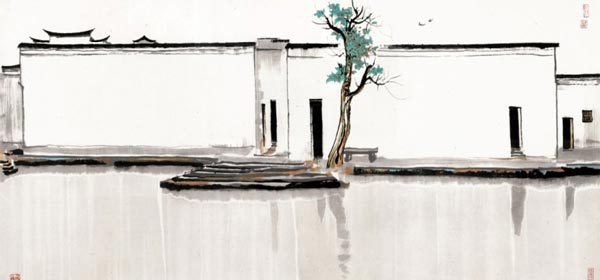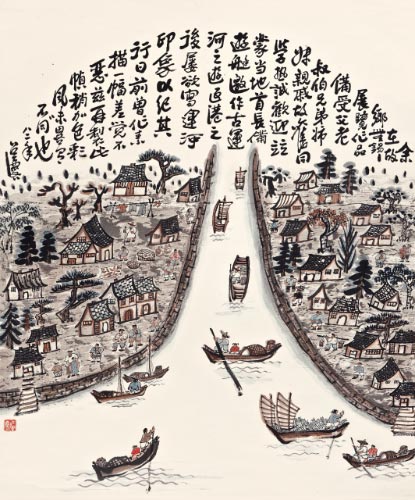Historic understanding of Chinese Guo Hua painting
Chinese painting is one of the oldest artistic traditions in the world. The materials used in Chinese Guo Hua painting are brush and ink on paper or silk. Once on paper, ink brushstrokes cannot be erased or corrected, so a painter must have a complete concept of the painting before the artwork begins.
Therefore it is no surprise that Chinese painting is closely related to Zen Buddhist and Daoist ideals of focus, concentration and harmony between man and nature. In Chinese paintings there is usually no attempt to capture the actual physical appearance of a subject, but rather its essential character.
Traditional painting involves essentially the same techniques as calligraphy and is done with a brush dipped in black ink or colored pigments; oils are not used. The finished work can be mounted on scrolls, such as hanging scrolls or handscrolls.
What means “Guo Hua Painting”
The dictionary definition of guohua is “traditional Chinese painting” (simplified Chinese: 国画; traditional Chinese: 國畫), though translated literally it means “national painting”, or sometimes an abbreviation for zhongguohua (“Chinese painting”). Less often you find the term guocuihua (“painting of national essence”) which has had a negative connotations since 1949 because of its origins in the National Essence Movement, a nativist cultural trend of the early republican period that became extremely conservative, both politically and socially.
In practice, a range of possible meanings for the term exists, which makes it difficult to translate accurately. Some painters use traditional materials to paint untraditional subjects or employ their materials in untraditional ways. For example Chinese paper with European pigments or, ink rubbings of paving stones, etc… Shortly you can say that works executed on Chinese paper or silk with predominantly Chinese pigments while showing traditional subjects can be called “Guo Hua painting” with no doubt.
Traditional painting techniques
There are two main techniques in Chinese painting:
- Gongbi (工筆), meaning “meticulous”, uses highly detailed brushstrokes that delimit details precisely. It is often strongly coloured and usually depicts figural or narrative subjects. It was often practised by artists that were working for the royal court.
- Ink and wash painting, in Chinese shuǐ-mò (水墨, “water and ink”) was often also called watercolour or brush painting. Interestingly in the Song dynasty this art was a kind of hobby of men that consider themselves as gentlemen.
Apart from techniques there are mostly three main subjects of Chinese painting: human figures, landscapes, and birds and flowers. Figure painting became highly developed during the Tang Dynasty, and landscape painting reached its height during the Song Dynasty. Later after Chinese painters were exposed to Western art during the nineteenth and twentieth centuries, new styles were evolving combining traditional Chinese painting with Western painting styles.
What makes a painting Guo Hua?
According to the writer, art historian and critic Xie He from the 5th century in China there are “Six principles of Chinese painting” to be considered which he wrote down in his book “The Record of the Classification of Old Painters” (古畫品錄).
- “Spirit Resonance”, or vitality, which refers to the flow of energy that encompasses theme, work, and artist. (today we would probably say does the artwork “connect” with you?)
- “Bone Method”, or the way of using the brush, refers not only to texture and brush stroke, but to the close link between handwriting and personality. (Does the work has an individual signature style?)
- “Correspondence to the Object”, or the depicting of form, which would include shape and line. (figurative aesthetics?)
- “Suitability to Type”, or the application of color, including layers, value, and tone. (harmony of color?)
- “Division and Planning”, or placing and arrangement, corresponding to composition, space, and depth. (appealing arrangement?)
- “Transmission by Copying”, or the copying of models, not from life only but also from the works of antiquity. (references to old masters?)
! Keep in mind that this was written circa 550 CE and refers to “old” and “ancient” practices, although I ad some remarks in parentheses.
A few works by “guo hua masters” from the late 19th









An finally some more modern interpretations








Like our story about Guo Hua Painting? Follow us on Facebook and Instagram.


